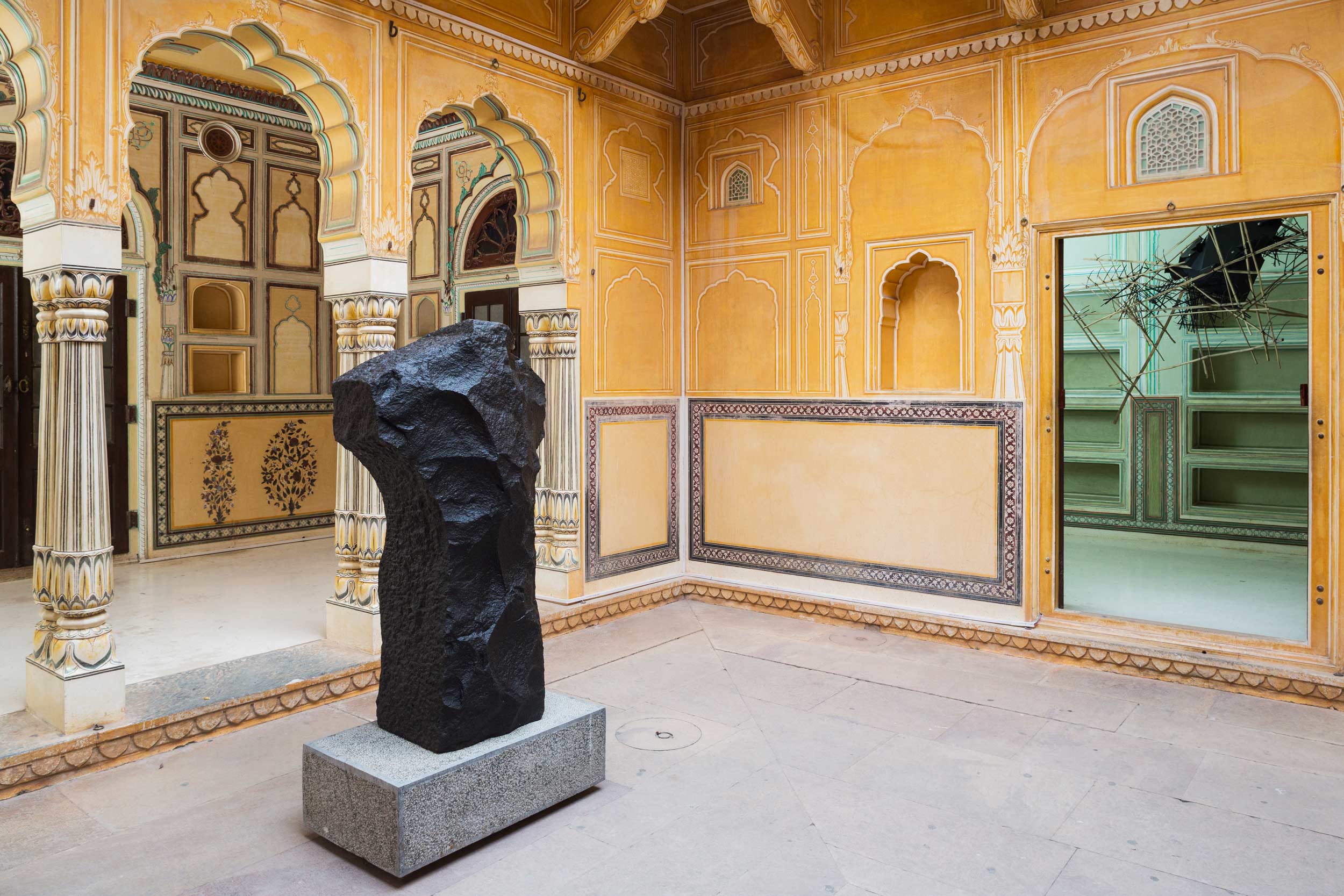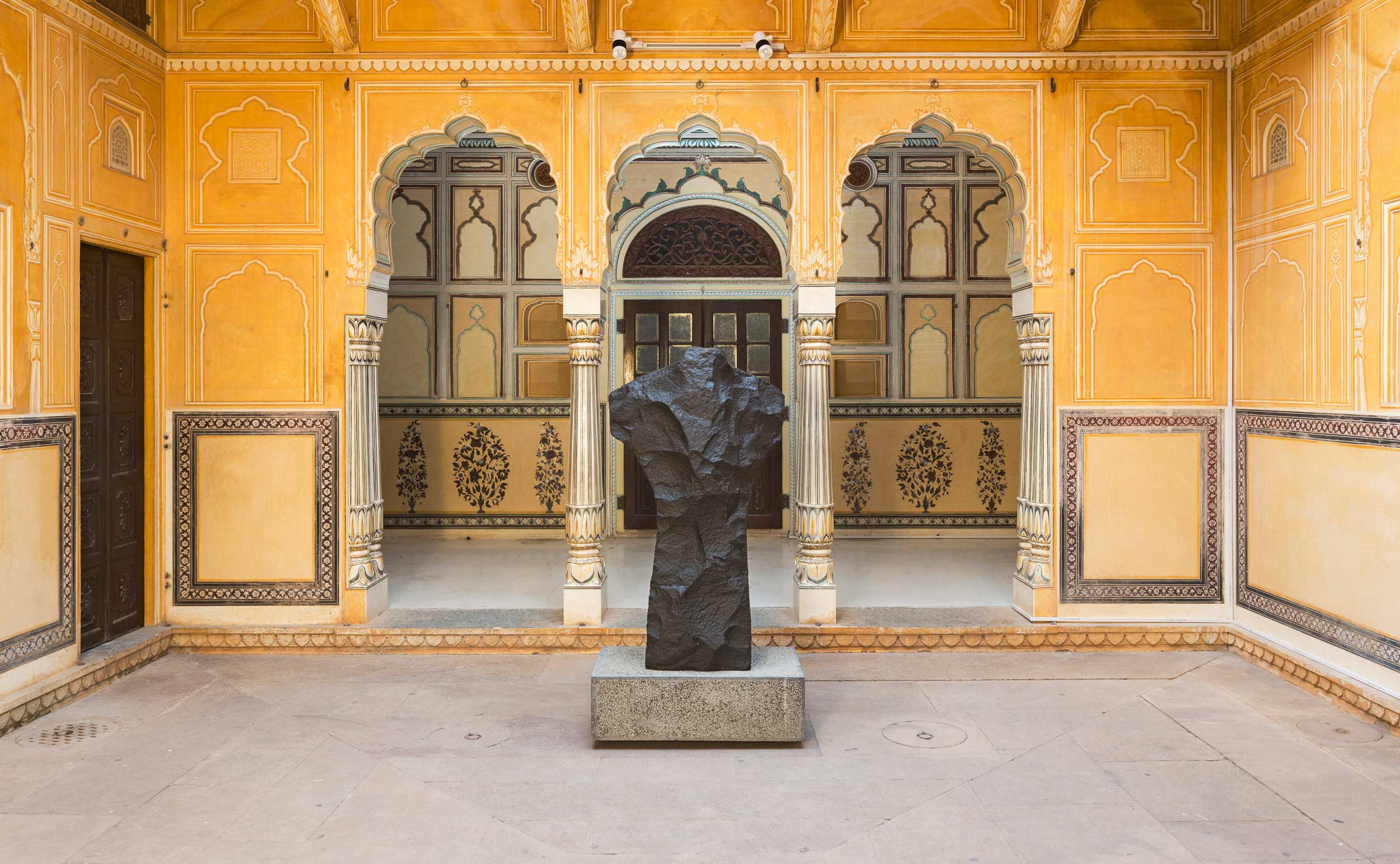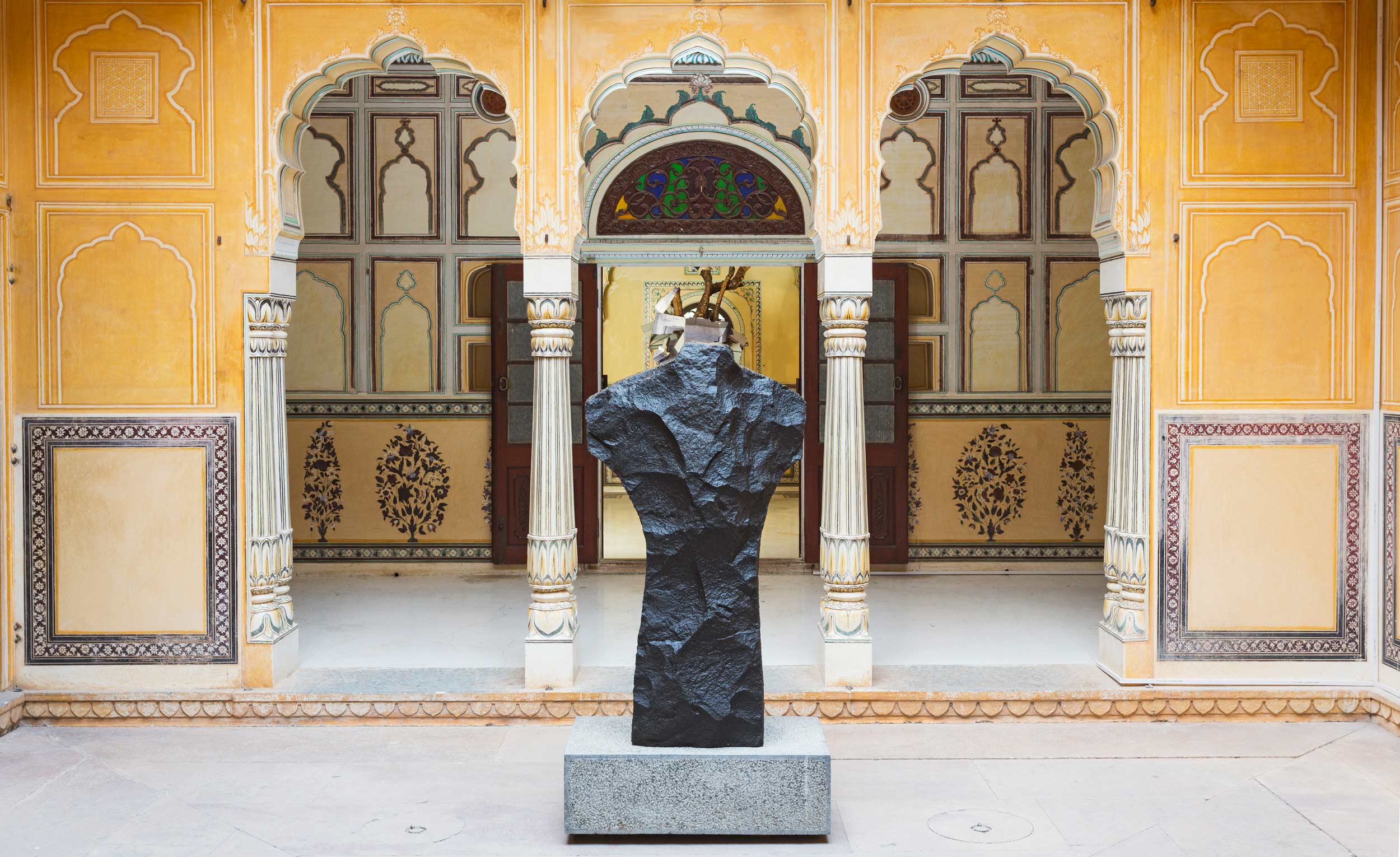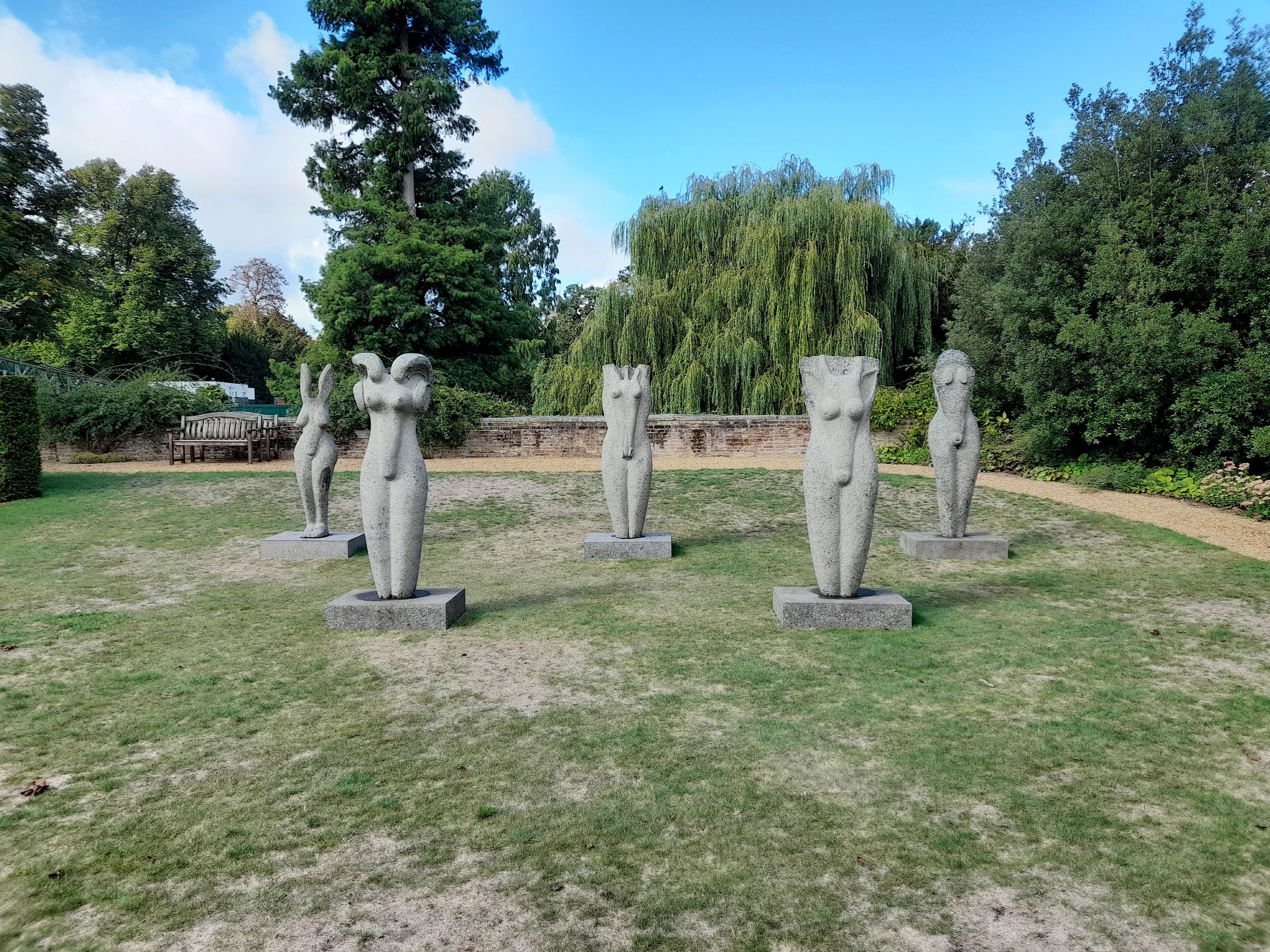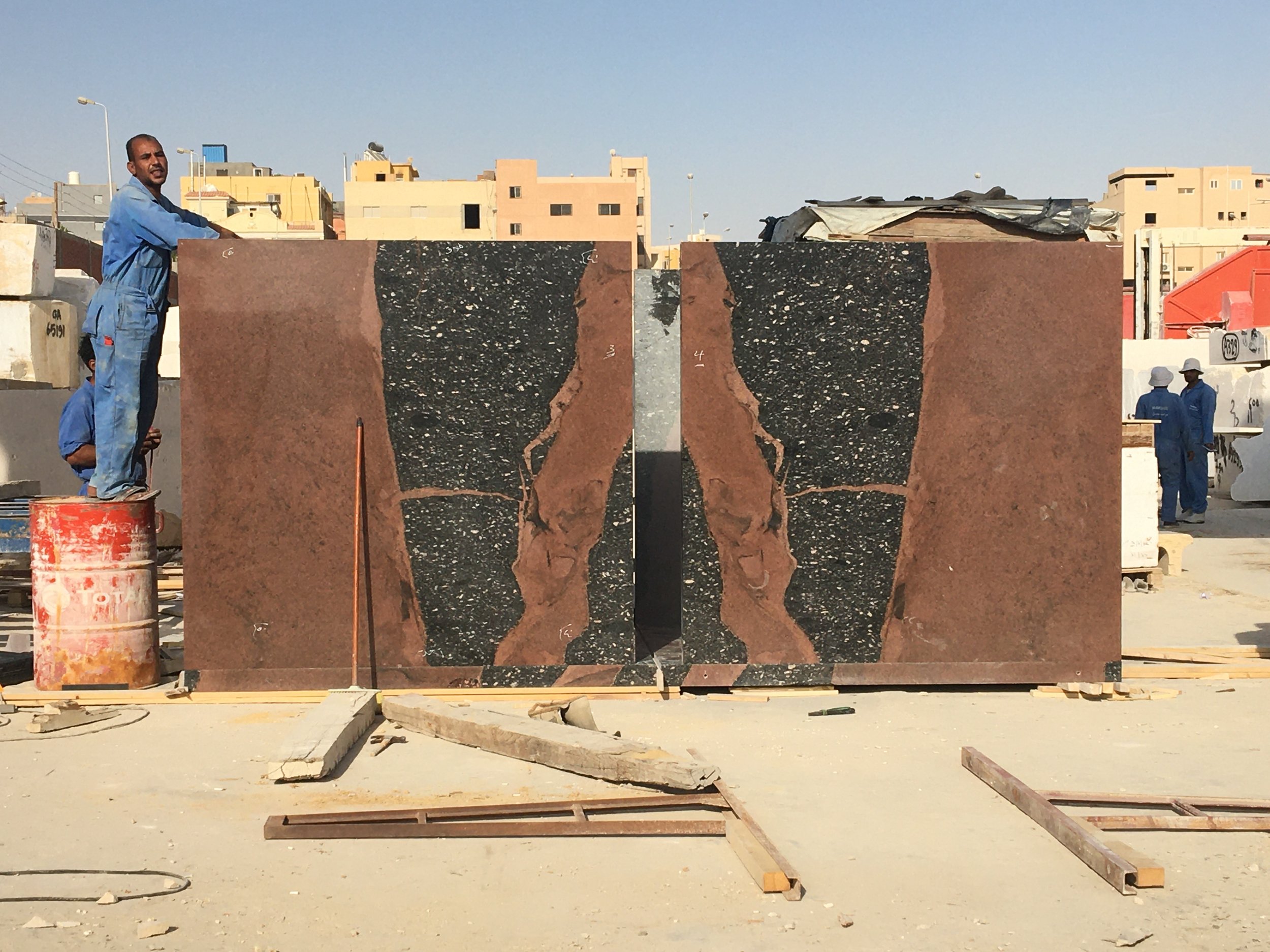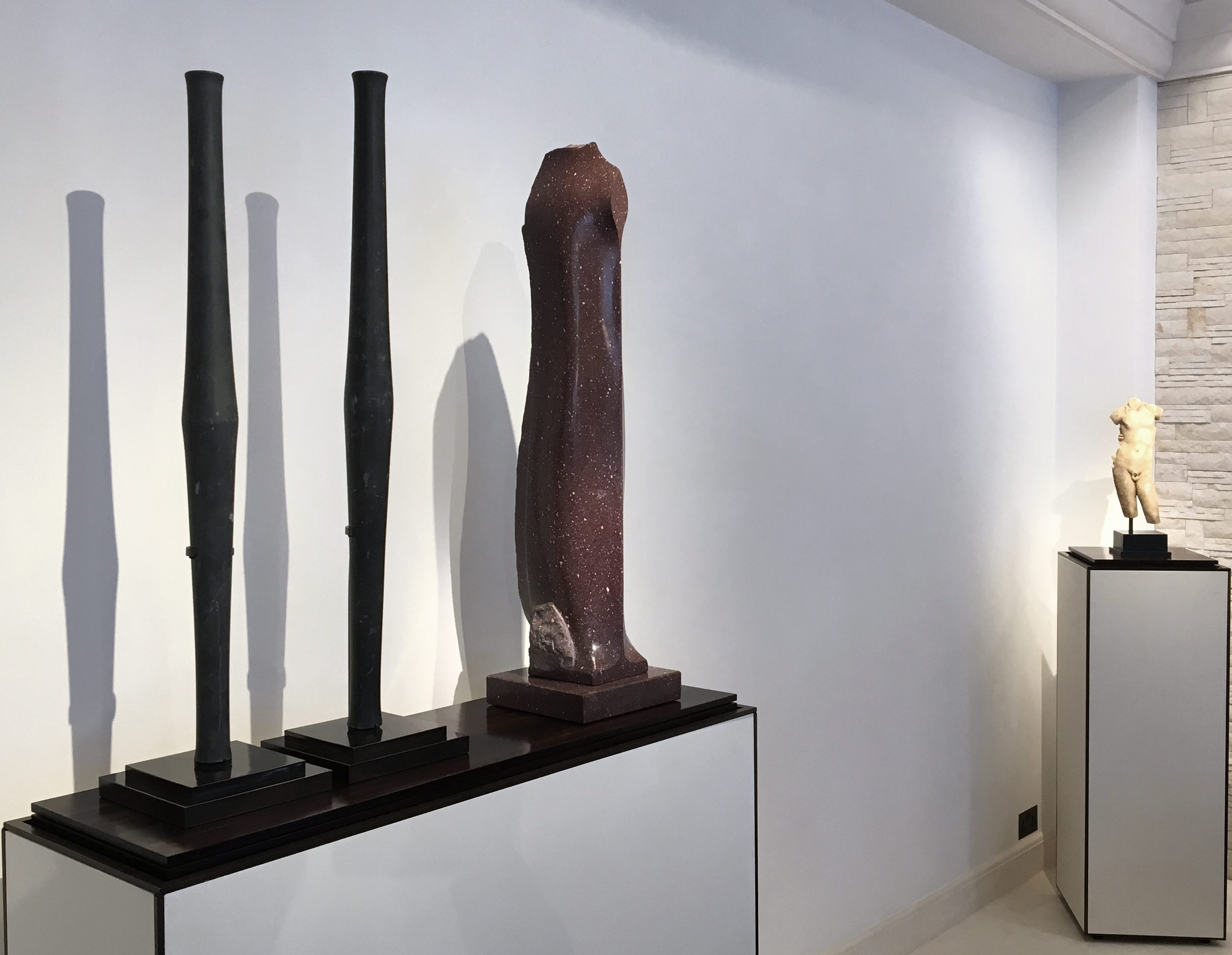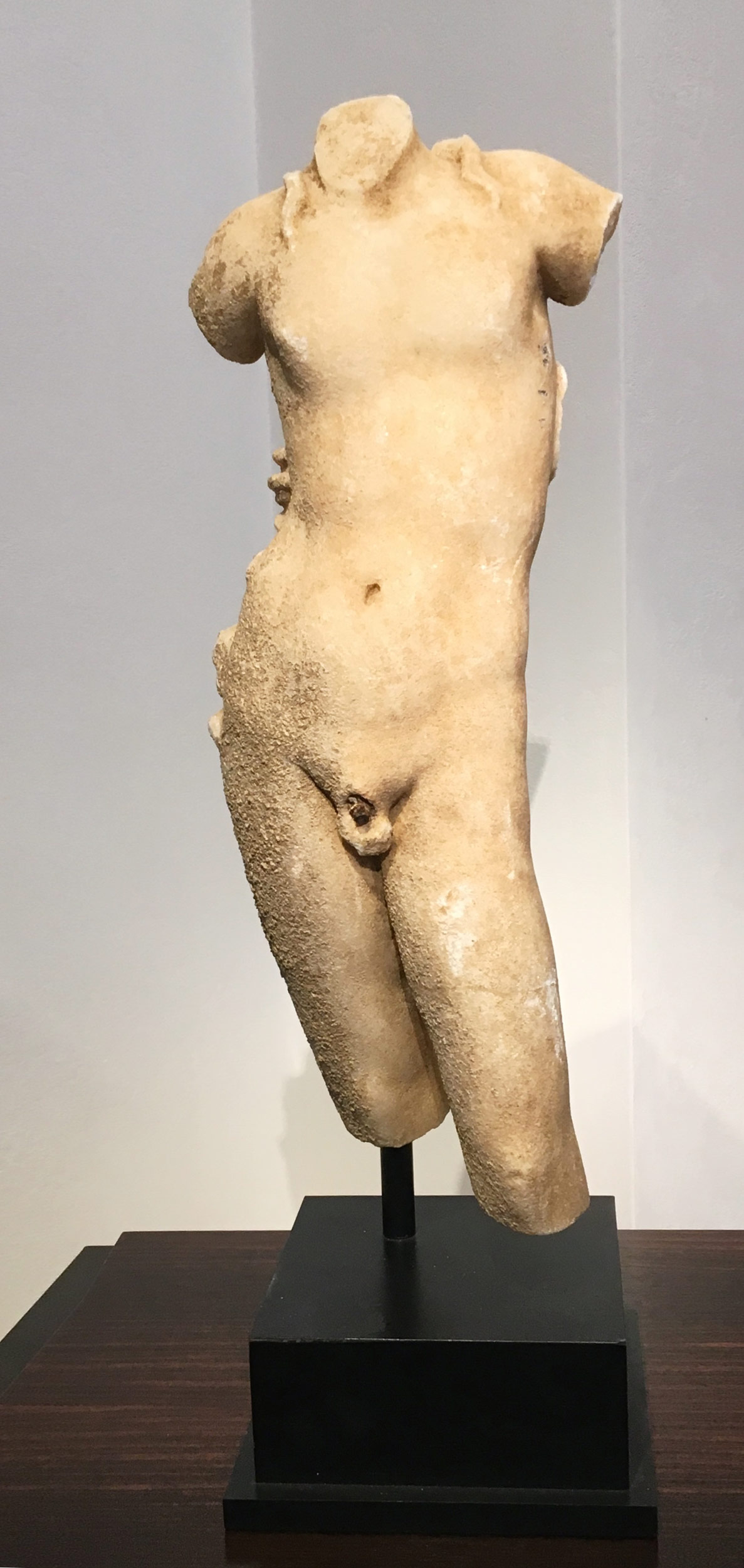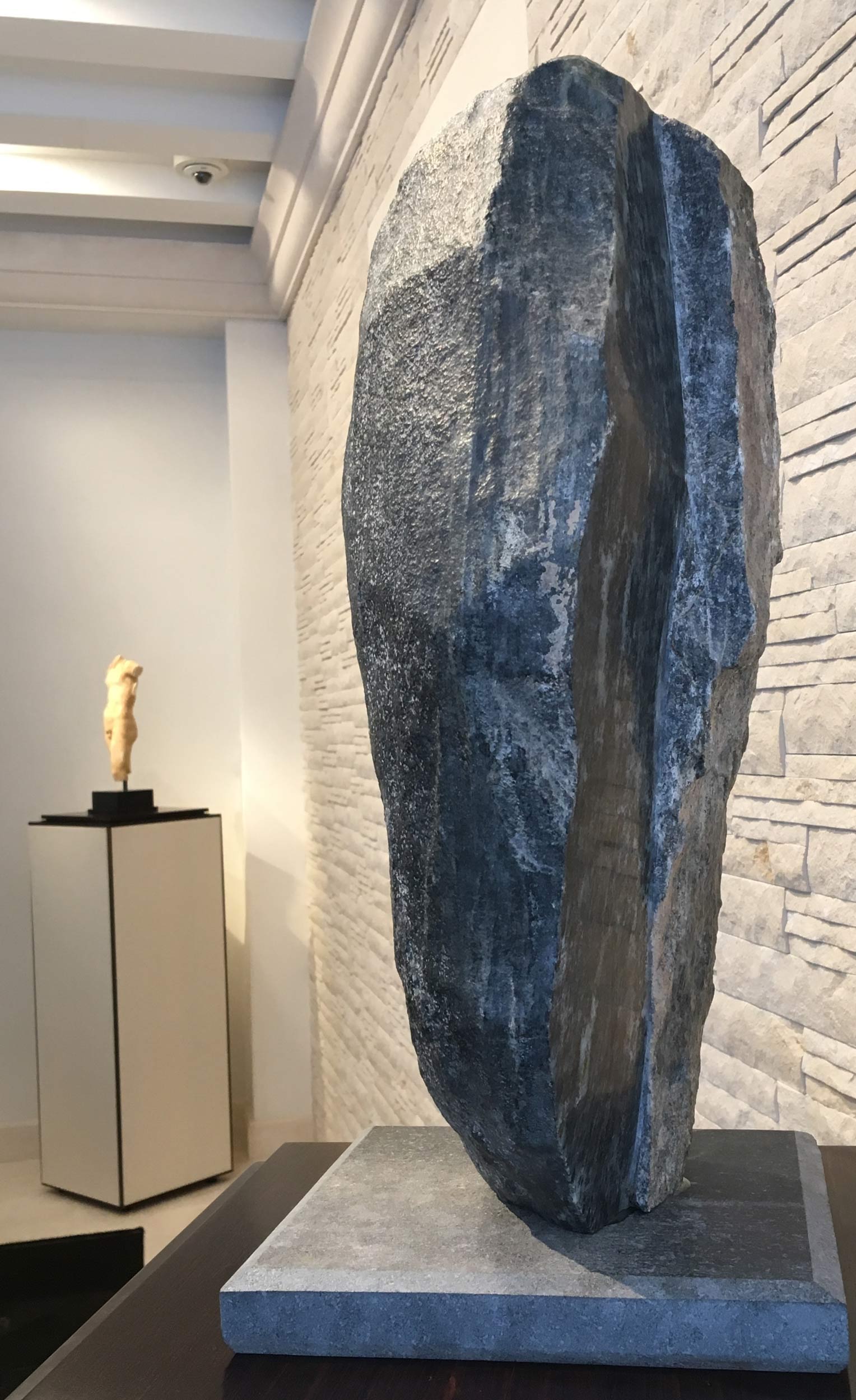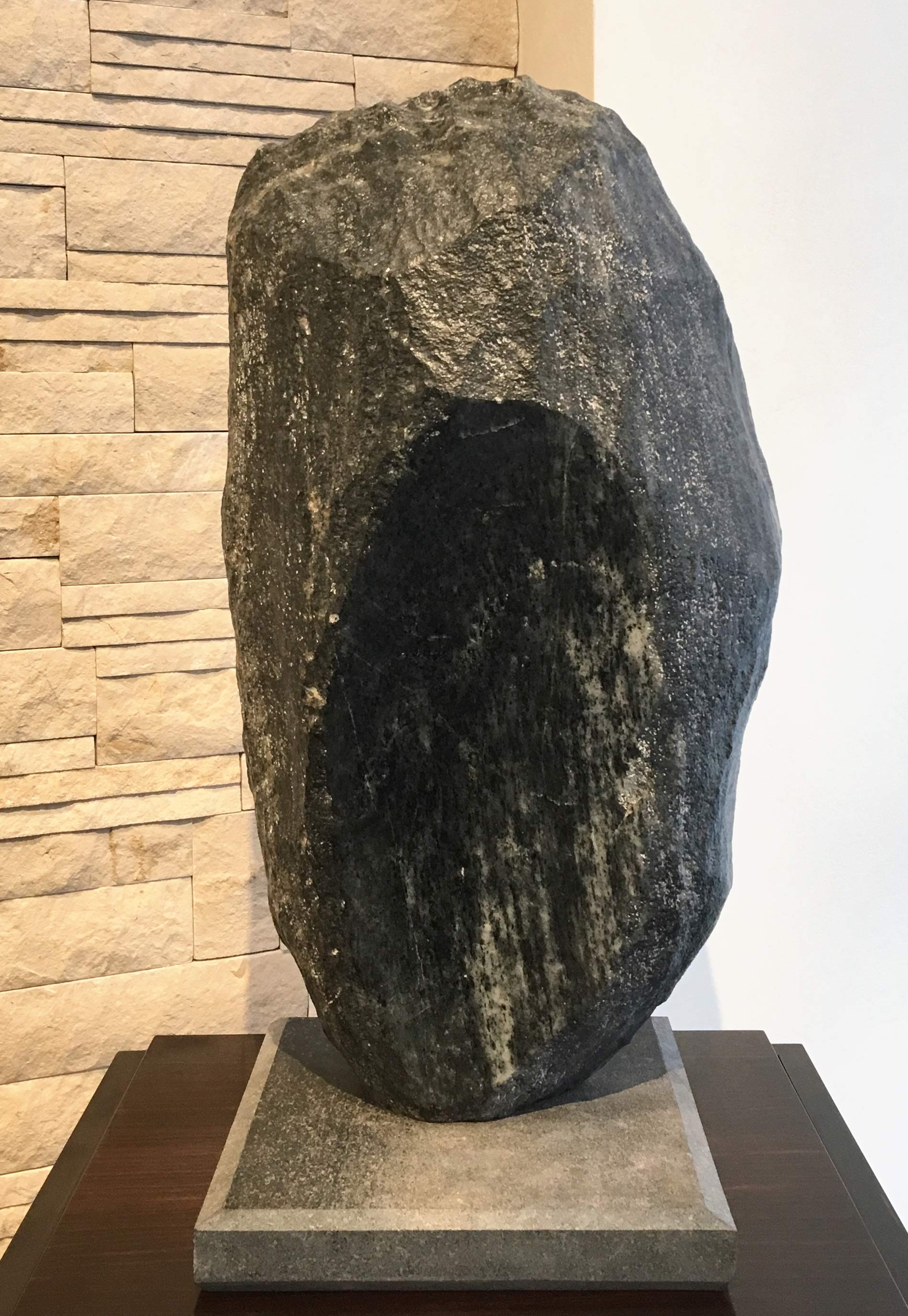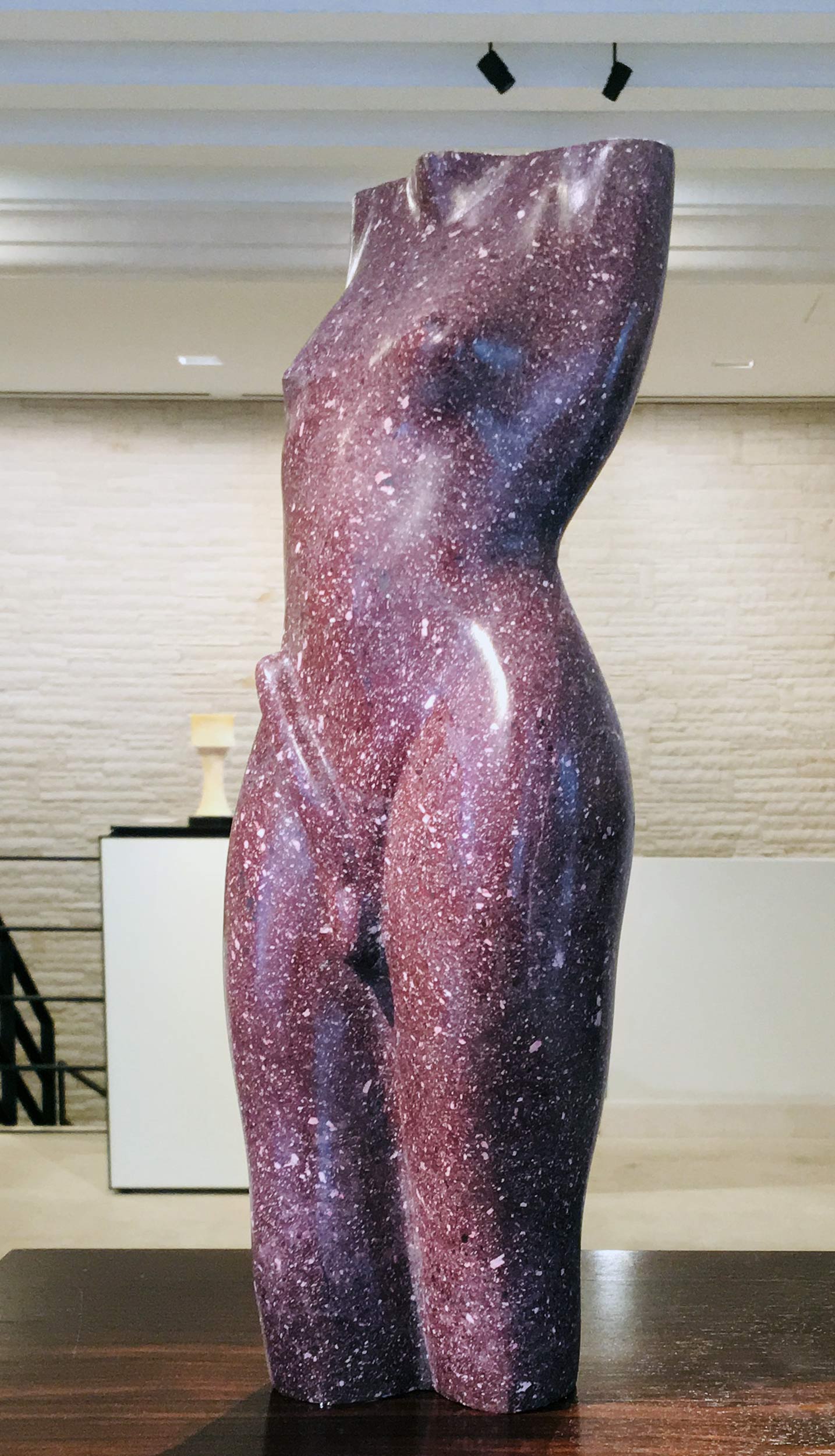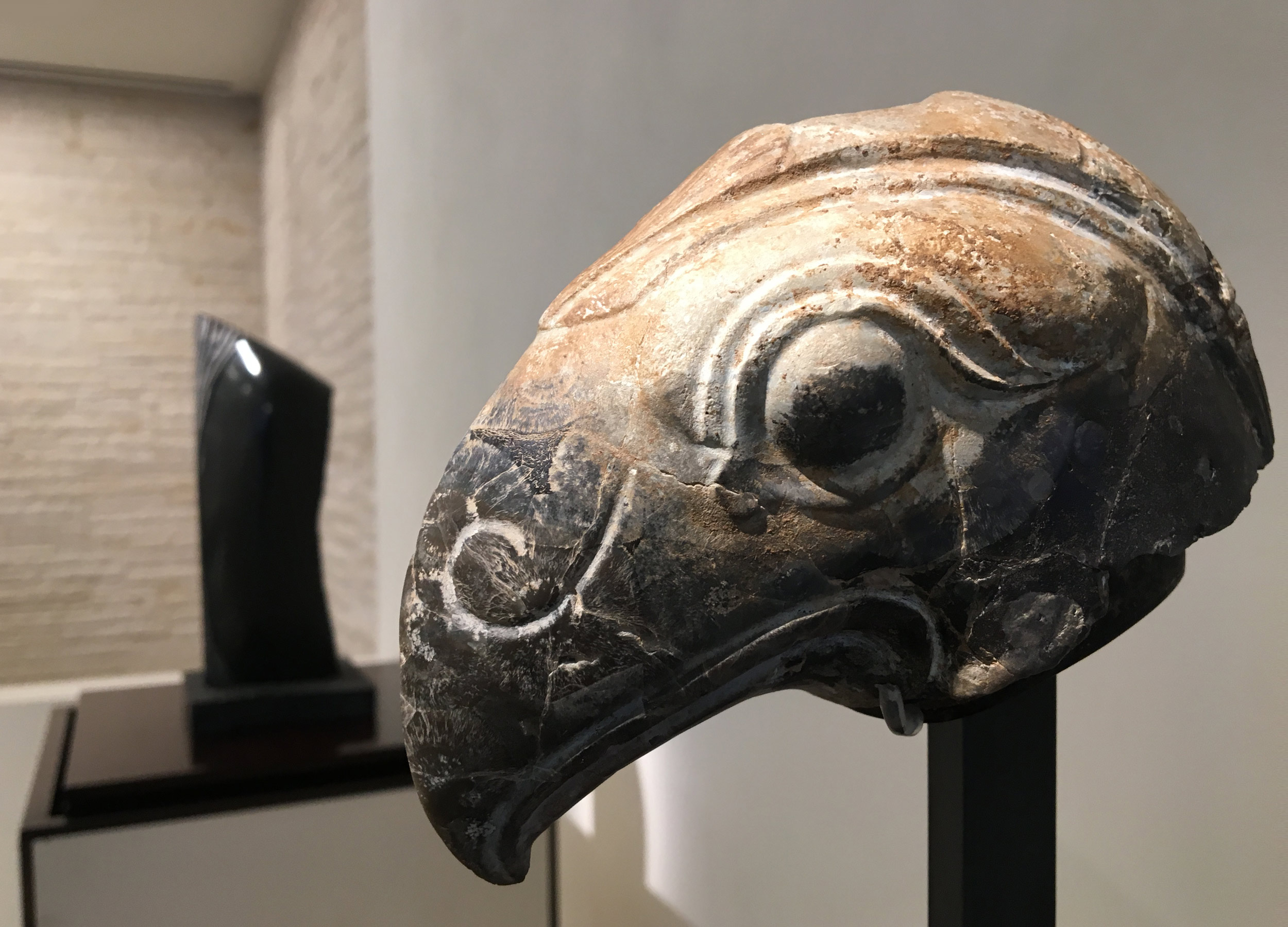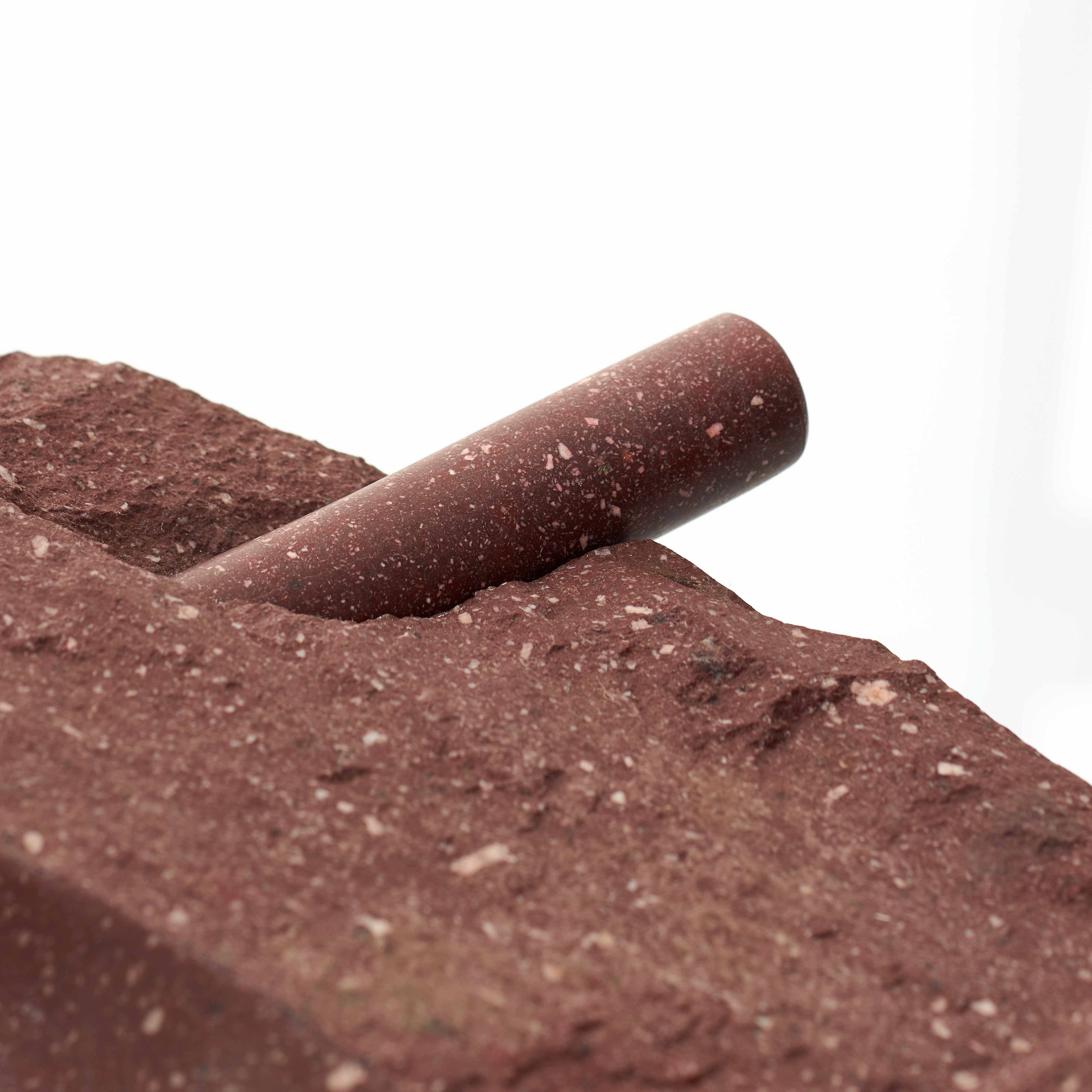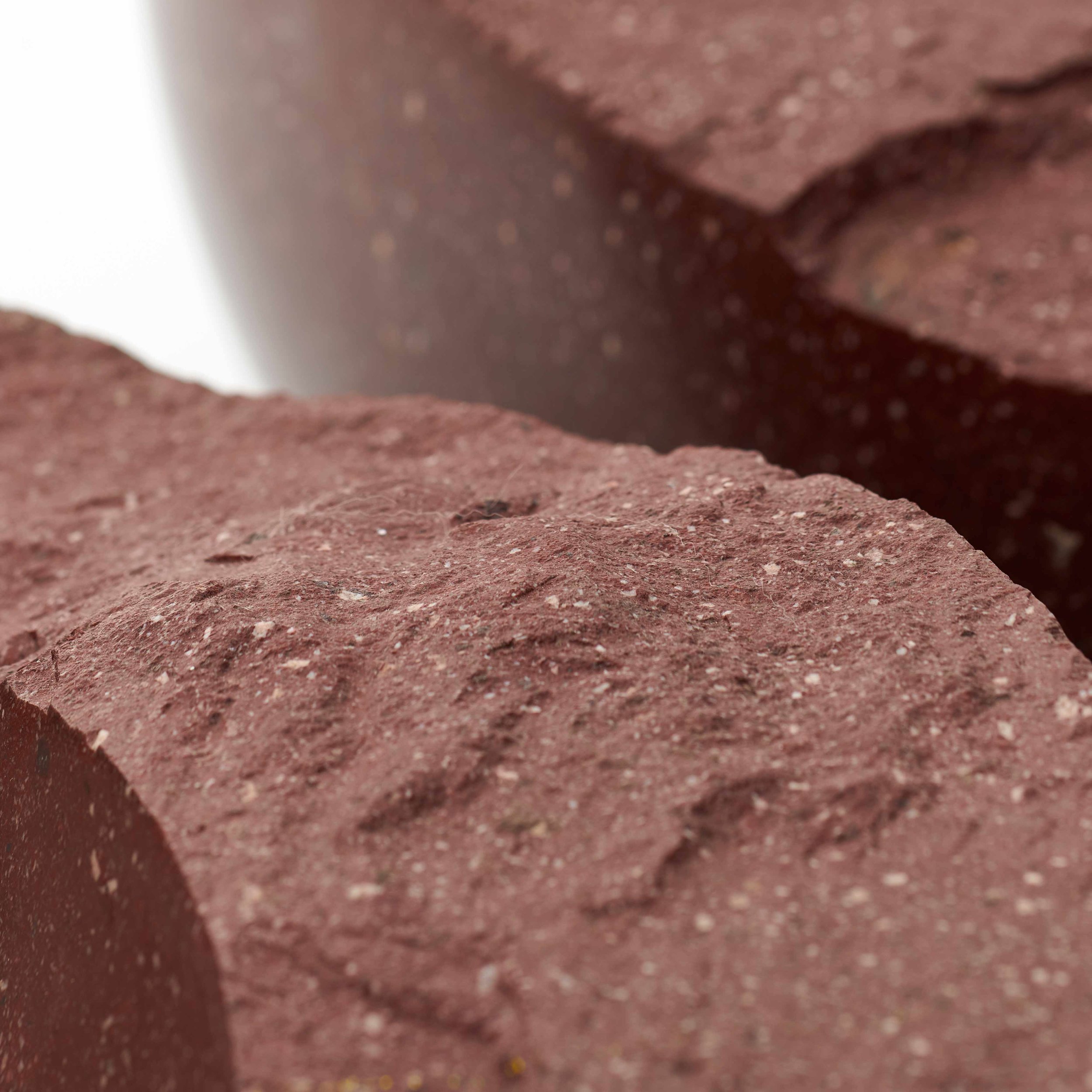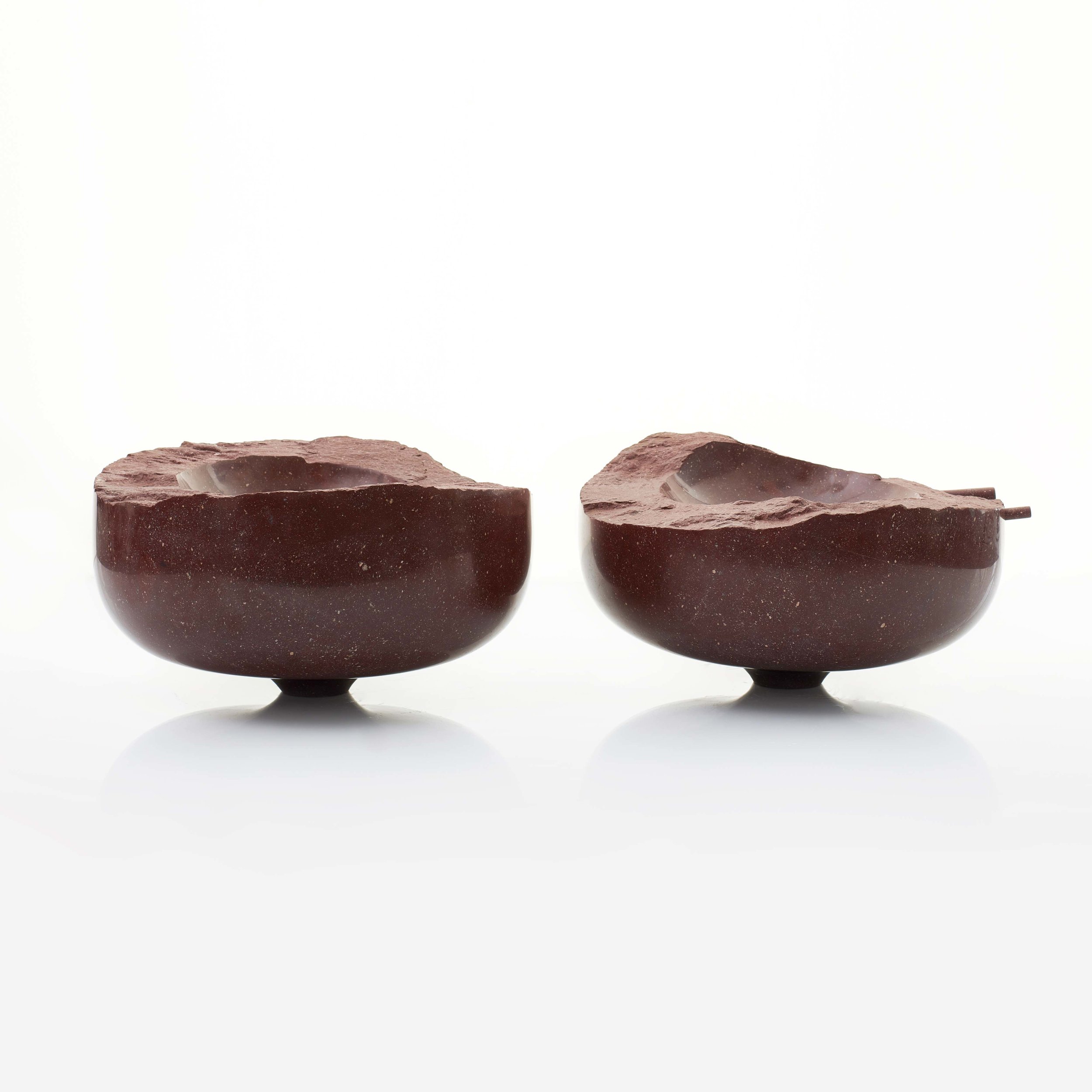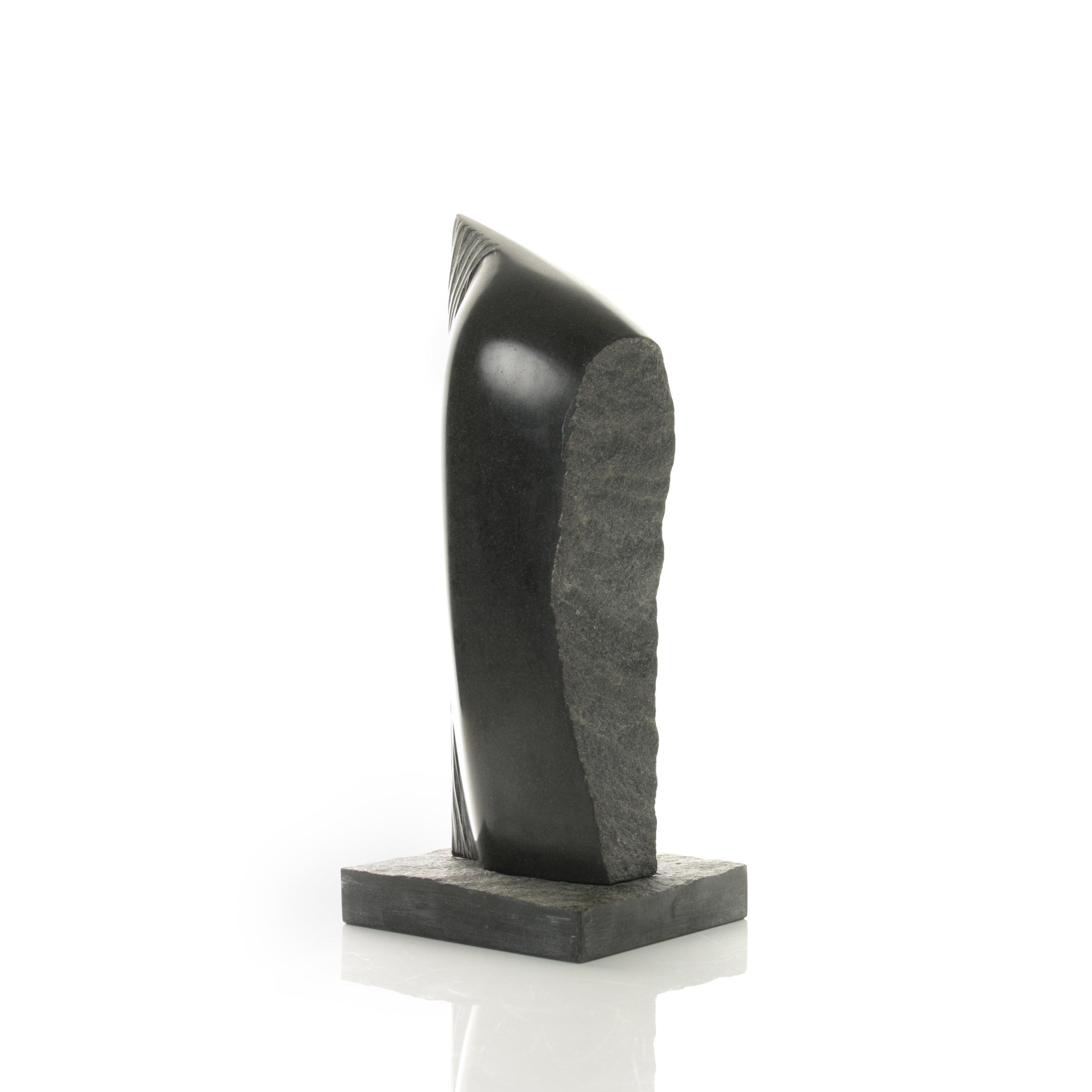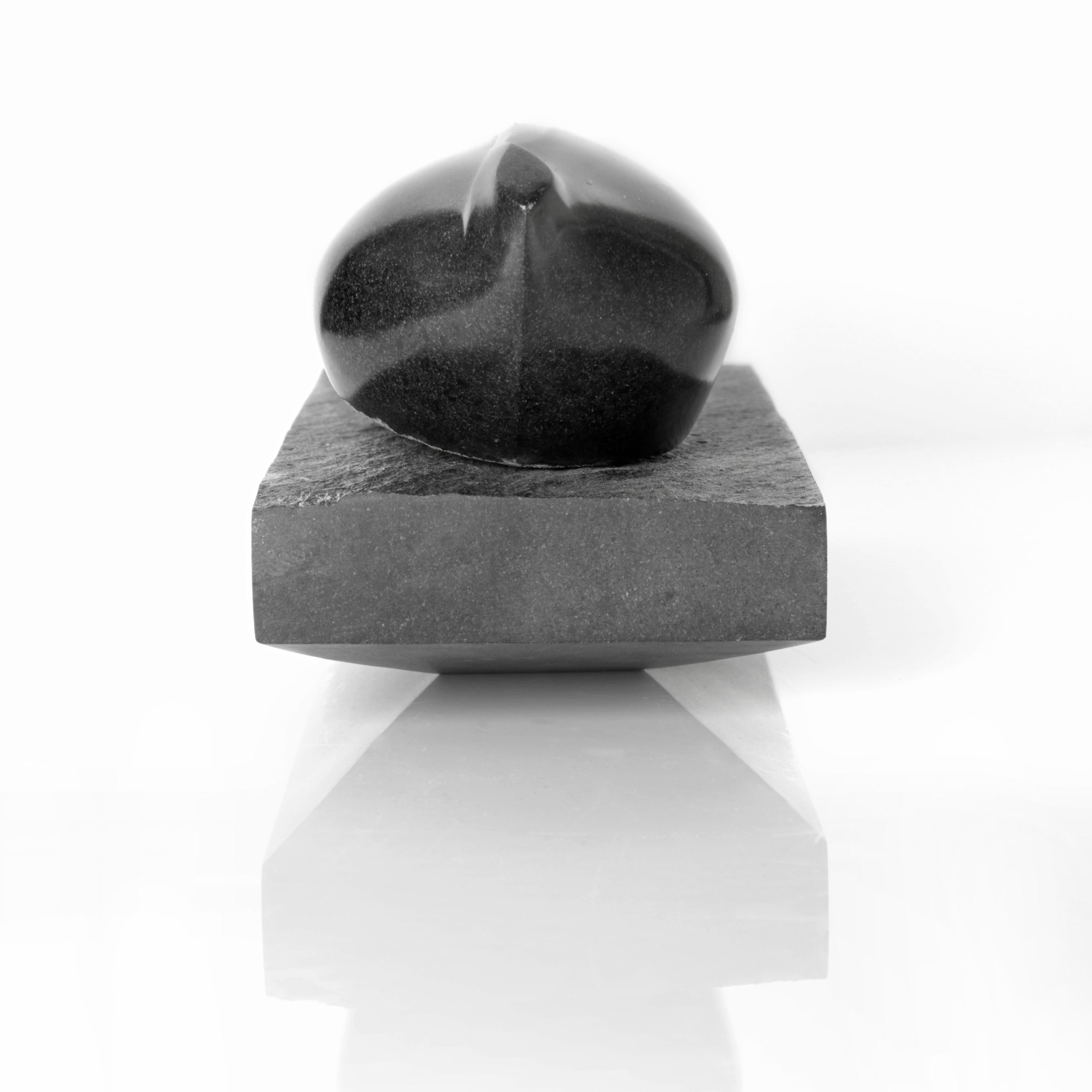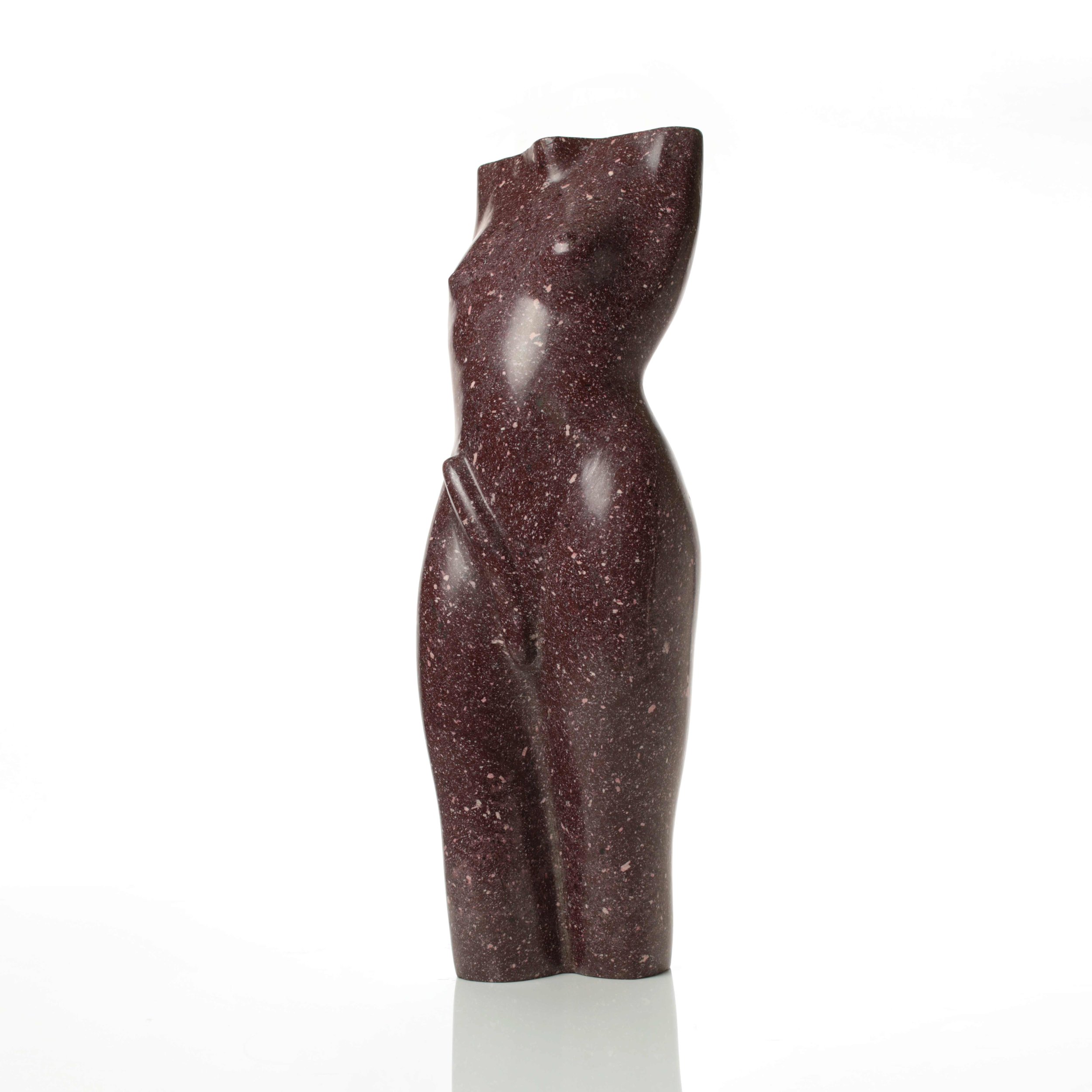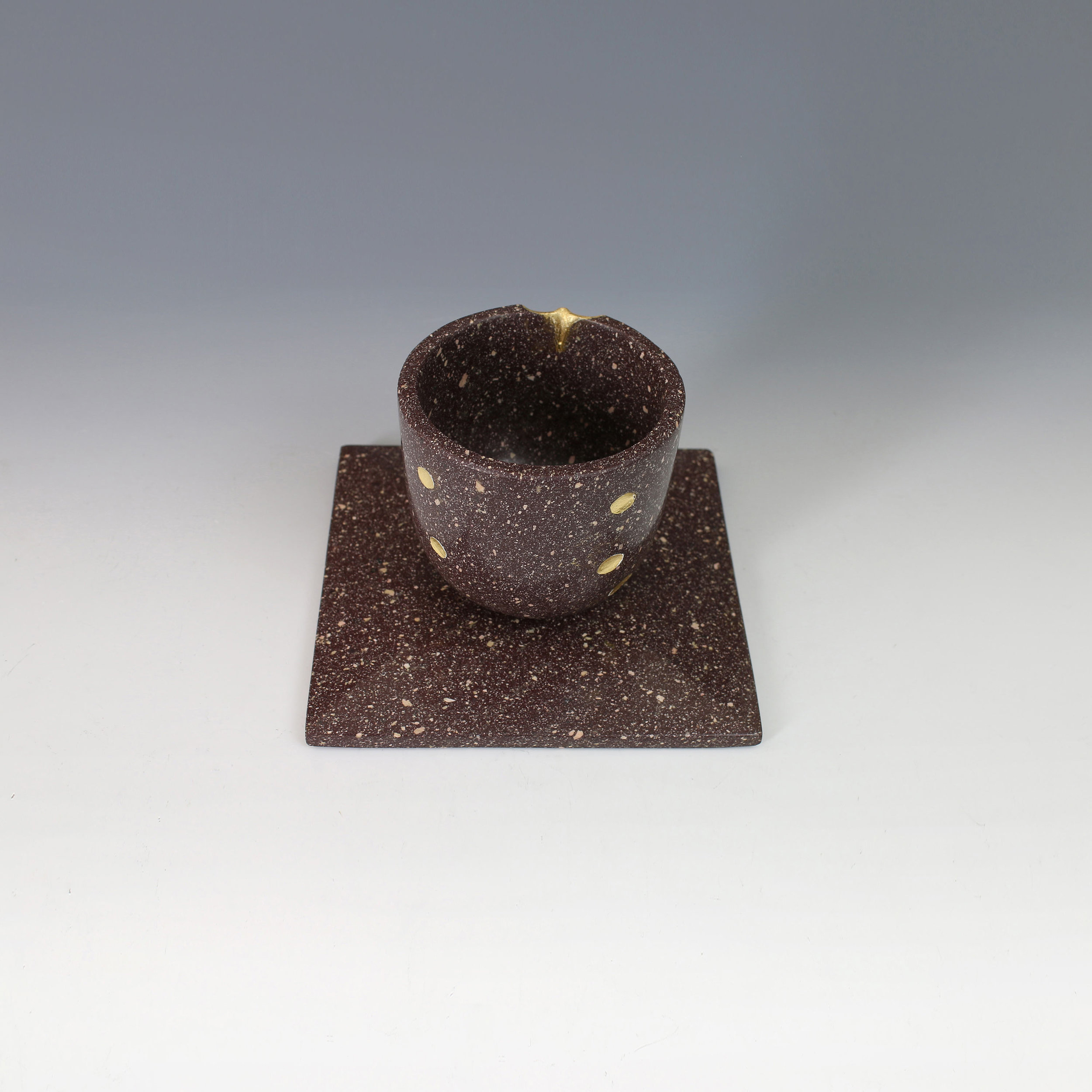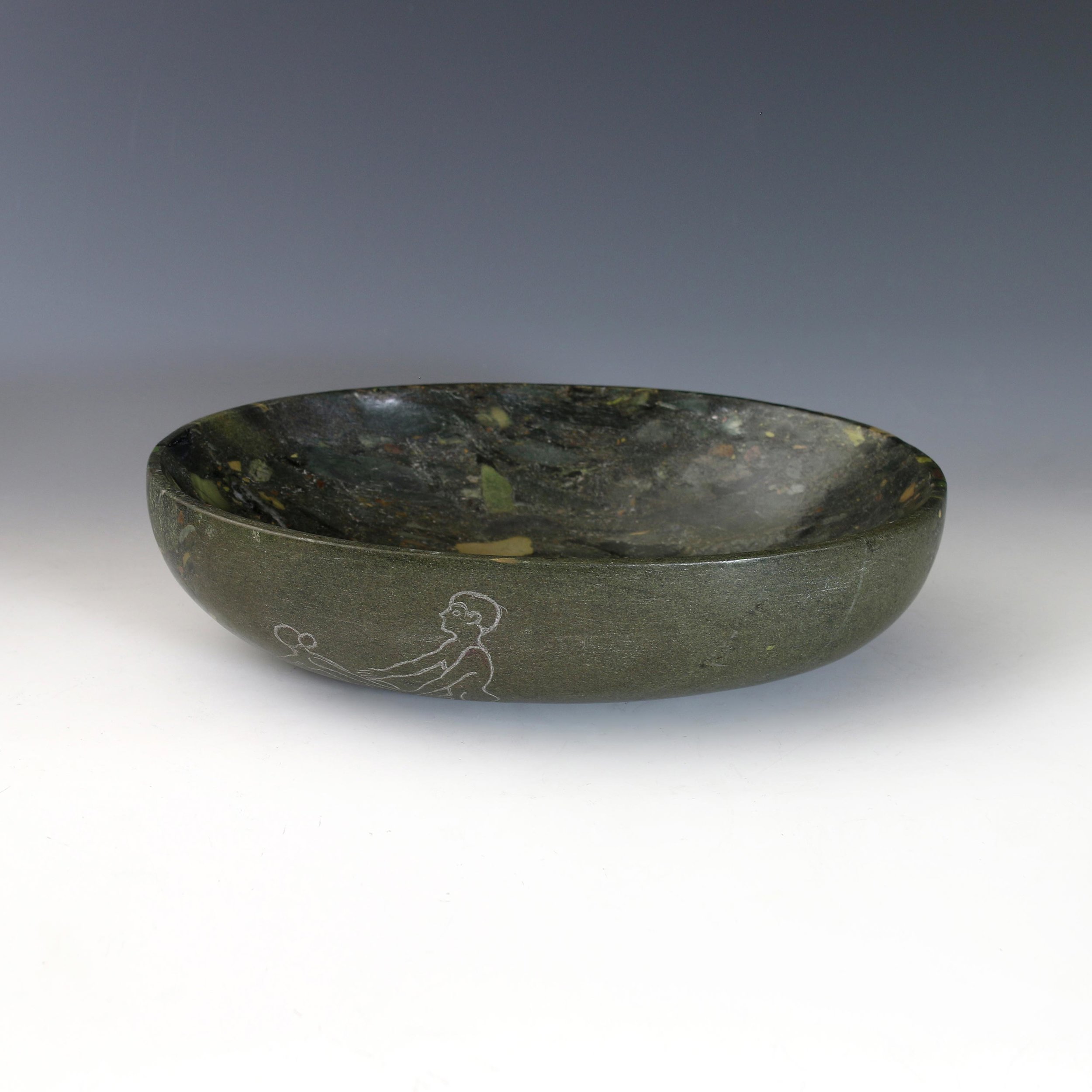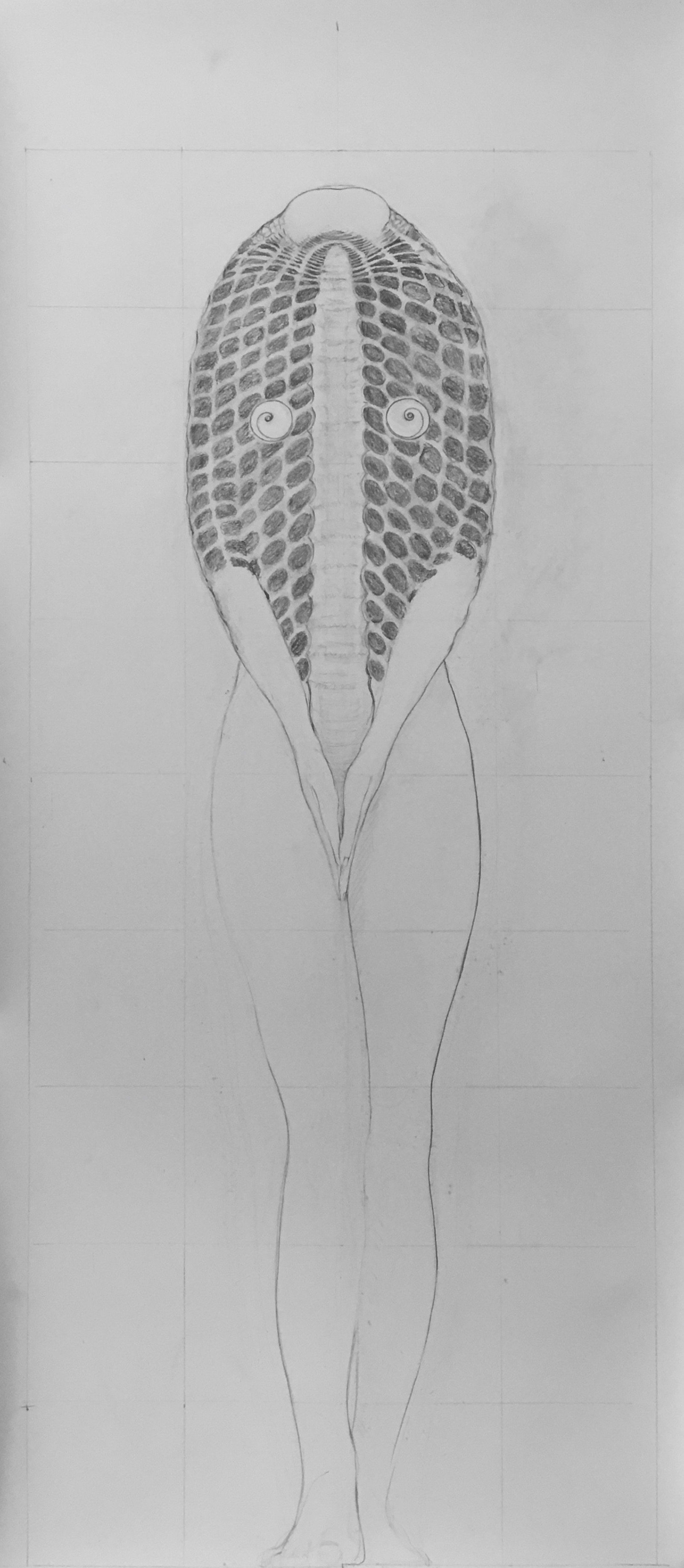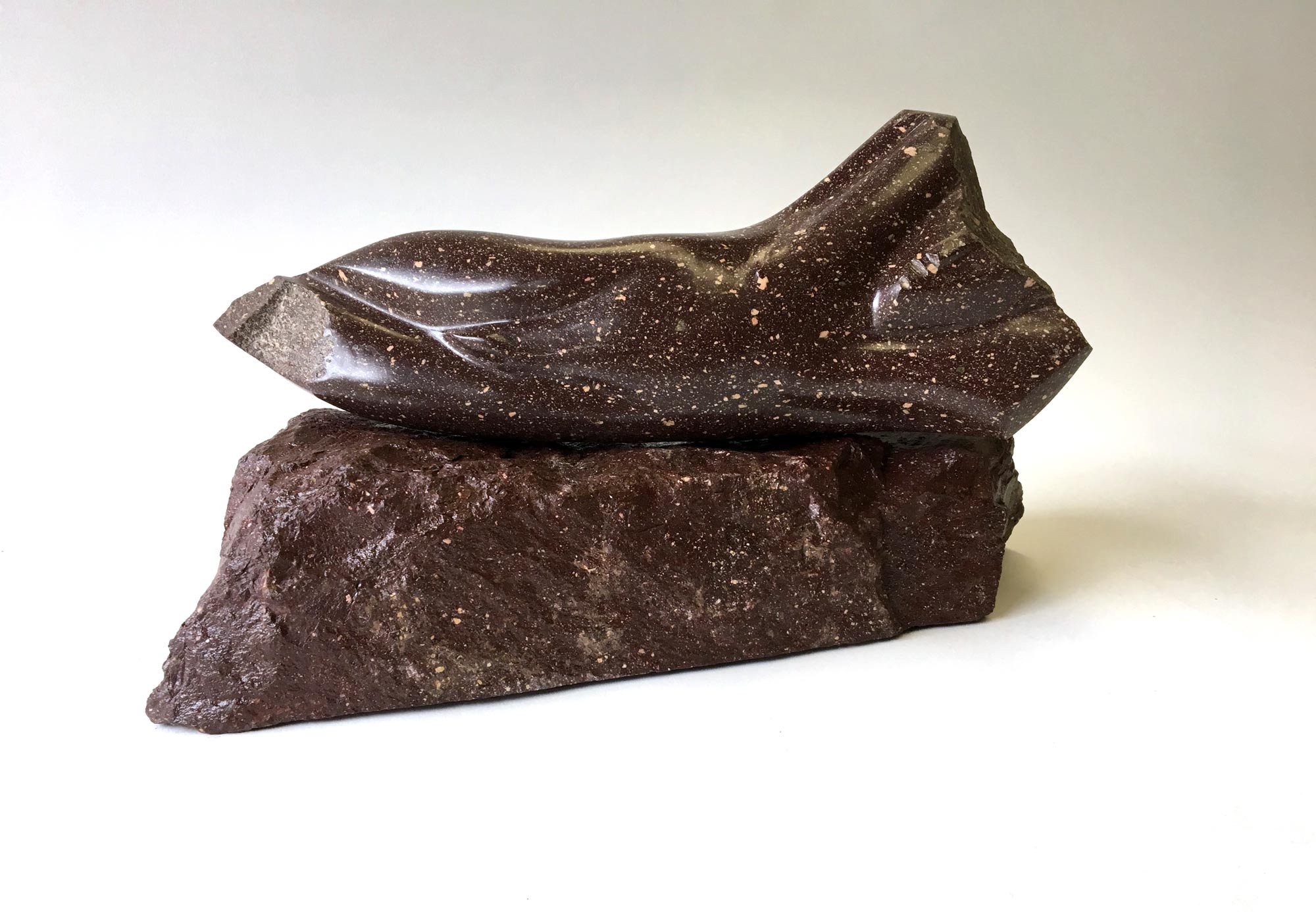Vogue Arabia: Pharaonic Grandeur Meets Palladian Architecture at Stephen Cox's Myth Exhibition
Through the work of sculptor Stephen Cox, Palladian architecture meets the pharaonic grandeur of Egyptian stone. Vogue travels back in time to the majestic Houghton Hall for Vogue Arabia
Through the work of sculptor Stephen Cox, Palladian architecture meets the pharaonic grandeur of Egyptian stone. Vogue travels back in time to the majestic Houghton Hall
October 12, 2025
Approaching Houghton Hall is like getting a glimpse of magnificence. A lengthy path through a deer park and open sky leads to the Palladian façade. Built in 1722 by Sir Robert Walpole, first Earl of Orford and first de facto British prime minister, this paragon of grandeur is no stranger to art. Now, that view has gained new gravitational pull, and the conversation has deepened with acclaimed British sculptor Stephen Cox’s stone creations taking their place amid William Kent’s 18th-century interiors and the Norfolk parkland. “The large sarcophagus pieces in rare marbles hold space in front of the house extremely well, while the smaller pieces in porphyry and other marbles work well in the State Rooms,” remarks Lord Cholmondeley, owner of Houghton Hall and a descendant of Sir Robert Walpole, the original master of the property. “The pieces on the marble tables in the Stone Hall are especially effective next to the ancient Roman heads and vases from the Walpole collection,” he adds.
Photography by Pete Huggins © Houghton Hall
Artlyst: Stephen Cox: Atavistic Sculptures Adorn Houghton Hall Norfolk – Sue Hubbard
Sue Hubbard reviews Stephen Cox’s “Myth” at Houghton Hall, Norfolk for Artlyst. It is an ambitious exhibition spanning 40 years of the British sculptor’s work. Set amid the opulent Palladian interiors and parklands of Sir Robert Walpole’s estate, Cox’s monumental stone sculptures in alabaster, porphyry, and granite create a powerful dialogue between ancient myth, material transformation, and 18th-century grandeur.
By Sue Hubbard
May 7, 2025
Houghton Hall, in Norfolk, was commissioned by the first British Prime Minister, Sir Robert Walpole. The interiors of this Palladian house are sumptuous, with opulent ceilings designed by the architect William Kent. Although much of its art collection has been sold off for tax purposes, the state rooms still pack a punch with their lavish tapestries, chandeliers, four-poster beds and gilded furniture that formed the backdrop to many a political meeting and glittering royal reception, reflecting the power and prestige of the Walpole family.
Photography by Pete Huggins © Houghton Hall
STEPHEN COX: MYTH
A major exhibition by the acclaimed British sculptor, Stephen Cox: Myth will be presented across the park, gardens and interiors of Houghton Hall from 4 May to 28 September.
Stephen Cox: Myth
Houghton Hall
4 May to 28 September 2025
A major exhibition, Stephen Cox: Myth is presented across the park, gardens and interiors of Houghton Hall, running from 4 May to 28 September.
The exhibition represents the largest and most comprehensive group of work the artist has ever shown. Spanning over 40 years, it includes work conceived and produced all over the world from India to Egypt, Italy and the UK.
More than 20 sculptures in marble and stone have been placed in the landscape, while smaller works are installed in the State Rooms on the first floor of the house, where William Kent’s exuberant decorative scheme has hardly changed since it was created in the early 18th century. A modern gallery space in the South wing of the house houses a group of works on paper together with a large marble and porphyry sculpture, Shrine, which was created for the celebrated Encounters exhibition at the National Gallery in 2000.
Photography by Pete Huggins © Houghton Hall
Dots Lines Checks opens at Kaash Gallery, Bangalore
This show features three bodies of work in Bidri, leather and the Chettinad strap weave. Hardstone, lighting, seating, art and light works that expand the lexicon of our work and investigate the possibilities of both simple and rarefied materials.
This show features three bodies of work in Bidri, leather and the Chettinad strap weave. Lighting, seating, art and light works that expand the lexicon of our work and investigate the possibilities of both simple and rarefied materials.
Professor Mary Beard in conversation with Stephen Cox RA
Join Professor Mary Beard and sculptor Stephen Cox RA for a discussion about art in antiquity.
Join Professor Mary Beard and sculptor Stephen Cox RA for a discussion about art in antiquity.
Those attending are encouraged to visit the Encounters in Stone exhibition in the College grounds beforehand. An exhibition catalogue can be purchased from the Porters’ Lodge. Part of the exhibition currently on display in the Graham Storey Room will also be available between 2pm and 6.30pm on the day of the talk. Please register via the online booking form.
Programme
The lecture will begin at 5.45pm and will be followed by a drinks reception which all attendees are welcome to join.
We would advise arriving early to take your seat – you may take your seat in the Lecture Theatre from 5.30pm.
Abstract
Sculptures on display at Trinity Hall will be the starting point for a conversation about art in antiquity between their creator, Stephen Cox RA, and classicist Professor Mary Beard.
Famous for her ground-breaking television series about the classical world Professor Beard’s knowledge of ancient artworks is second to none.
Mr Cox’s work is inspired by the ancient world and the stones he uses are often directly sourced from quarries used by the civilisations of antiquity. The discussion will include the artist’s experience in quarrying Imperial Porphyry from its source in the Eastern Mountains of Egypt along with Hammamat Breccia and Chephren Diorite.
Professor Beard and Mr Cox will also discuss Aswan Granite and how it was used in the production of one of the artist’s sculptures dedicated to the Egyptian Pharaoh Khafre that was exhibited 2 years ago on the Pyramids Plateau adjacent to his Pyramid.
Stephen Cox: Dialogues in Stone opens at the Museum of Art and Photography, Bangalore
As a part of the inauguration, MAP will be showcasing the sculptures of Stephen Cox, a British sculptor who has spent a considerable amount of time working in India. His sculptures of Yoginis and Rishis carved in basalt greet audiences as they enter the museum. Drawing from Cox’s observations of architectural sites and monuments in the region, they embody mythical beings through minimalist forms.
The titles of these sculptures – yoginis and rishis – refer to powerful goddesses and sages. The yoginis were part of an esoteric cult, where only a small group of individuals held knowledge about these goddesses. Enshrined in open temples and shrouded in secrecy, yoginis possess magical powers that evoke both fear and awe. Cox’s sculptures are contemporary interpretations of these goddesses, blending animal and human forms, a hybridity referenced in ancient Indian texts and one the artist has encountered in Middle Eastern, Egyptian, Greek and Roman iconography.
The smoothness of stone in the yoginis is contrasted to the rough and textured form of the rishis. Associated with knowledge and truth, the rishis take the form of torsos and other irregular shapes. The minimal intervention to the stone reflects the austere nature of rishis. In doing so Cox breathes life into intractable stone, capturing the essence and spirit of primordial figures.
Cox works with local material, using stone extracted from quarries to the east of Kanchipuram, a city in Tamil Nadu. A team of stone carvers in Mahabalipuram give shape to these sculptures. These stones, known as basalt, were also used in the construction of ancient temples. His sculptures thus bring to light an ancient material into a contemporary setting; the incisions made to these stones are preserved, bearing the marks of time
Museum of Art & Photography (MAP) Bangalore
The exhibition runs from February 18, 2023 - February 18, 2024
Stephen Cox Sculptures installed at the Museum of Art and Photography, Bangalore
A group of ‘Yoginis’ and ‘Rishis’ by Stephen Cox have just been installed at the Museum of Art and Photography, (MAP) in Bangalore, India.
The Museum of Art and Photography, (MAP) in Bangalore, India is due to open on the 9th December 2023 and this group of ‘Yoginis’ and ‘Rishis’ by Stephen Cox have just been installed. All these works are made in Indian Basalt and can be found in the Sculpture Courtyard of this impressive new museum.
Stephen Cox 'Encounters With Stone' at Camridge University
This exhibition situates monumental sculptures and small-scale pieces, made by Stephen Cox, throughout the courts and gardens of Trinity Hall, Camrbidge.
This exhibition situates monumental sculptures and small-scale pieces, made by Stephen Cox RA, throughout the courts and gardens of Trinity Hall, Camrbidge. Cox blends a deep knowledge of the stones from Italy, Egypt, and India, as well as the beliefs, myths, and customs they historically manifest, with his own aesthetic as a contemporary sculptor.
Opened 9th August 2022 untill July 2023
Trinity Hall Cambridge
Gemini III
Egyptian breccia
Avery Court
Cycladic Gemini 2019
Egyptian Alabaster
Circular Lawn
Conjunction
Indian Dolerite
Fellows Garden
Five Yoginis
Shrouded Peregrine 2011
English Basalt / Dolerite
Creation and Installation of 'Interior Space: For Khafre' by Stephen Cox 2021
“Forever Is Now” was an exhibition of contemporary art focused around international contemporary perspectives of ancient Egyptian civilization. It was held in 2021 at the Pyramids Plateau, Giza, Egypt.
“Forever Is Now” was an exhibition of contemporary art focused around international contemporary perspectives of ancient Egyptian civilization. It was held in 2021 at the Pyramids Plateau, Giza, Egypt.
It explored time as a continuum that divides and connects civilizations. Through blending rich cultural history and contemporary artwork it aimed to trace the continuity of ideas from the mythical past to the vibrant present, and to inspire the future of humanity.
New works going to TEFAF Maastricht 2020
Stephen has recently completed a substantial body of new works that are pictured below. They will be on show on Adrian Sassoon’s stand at TEFAF in Maastricht between the 7th and the 15th of March 2020.
Stephen has recently completed a substantial body of new works that are pictured below. They will be on show on Adrian Sassoon’s stand at TEFAF in Maastricht between the 7th and the 15th of March 2020.
Review of R.A. Summer show 2019
A review of The RA Summer Exhibition that sees Stephen Cox’s wor as one of the few redeeming pieces in an otherwise disapointing presentation.
Summer Exhibition 2019, Royal Academy of Arts, review: like an emporium offering deals on last season’s stock
Alastair Sooke, Critic at large
Royal Academy of Arts Summer Exhibition Credit: David Parry/PA
After the party, the hangover. Last year, to celebrate the 250th Summer Exhibition, the Royal Academy pulled out all the stops by appointing their most popular and exuberant Academician, Grayson Perry, to make everything feel like a knees-up.
Happy to oblige, he gave the walls several licks of bright, gaudy paint, plonked a raucous, bulging woollen sculpture, decorated with tinkling ornaments and colourful felt, by the Portuguese artist Joana Vasconcelos, in the octagonal central hall (where it greeted visitors like a larger-than-life maître d’), and generally upped the levels of fun and pageantry. It was always going to be a tough act to follow.
Unsurprisingly, Jock McFadyen, the British painter, who accepted the poisoned chalice of succeeding Perry as co-ordinator, cannot prevent this year’s Summer Exhibition feeling like a comedown. The colours of the walls are more subdued, the usually rumbustious, jostling hang is, in places, surprisingly sparse, and in the courtyard outside Burlington House, British sculptor Thomas Houseago presents a group of powerful but brooding, downbeat figures – stooped and hobbling bogeymen, with skull-like grimaces. That’s how I feel the morning after a big night out, too.
Those in need of pain relief should head for Honorary Academician James Turrell’s soothing light installation, tucked away in the Small Weston Room: with its diamond-shaped “window” onto a void of softly glowing lights, it is the visual equivalent of an analgesic drug.
In a passably witty joke at the RA’s own expense, McFadyen turns the central hall into a “menagerie”, playing on the well-worn idea that the Summer Exhibition – the largest open-submission art show in the world (this year, there were more than 16,000 entries, of which less than a tenth ended up on display) – attracts enough amateur animal paintings to fill Noah’s Ark. Here are pictures of fish, a gorilla, and a rhinoceros, as well as lots of sculpted dogs.
Royal Academy of Arts Summer Exhibition Credit: David Parry/ PA
Look up, and you will spot a model of the famous 17th-century Dutch painting of a pet goldfinch by Rembrandt’s pupil Fabritius, its golden chain extending all the way to the floor. Is it cowering from the life-size tiger slinking nearby, by the Scottish sculptor David Mach? Maybe not: this big cat’s shiny, red-and-silver pelt is made from flattened foil confectionary wrappers from M&S. Yum! Mach’s predator is really a sweet pussycat.
That Marks & Spencer branding tells you everything you need to know about the Summer Exhibition, which is now as solidly middle-class as Elephant’s Breath by Farrow & Ball. Nothing wrong with that, you might say, except it makes for a bland viewing experience, offering about as much excitement and surprise as the decoration on a Cath Kidston mug.
Take the grandly cavernous Gallery III, traditionally hung by the exhibition’s co-ordinator. Mixing up photography and painting, McFadyen includes a photo of vintage books arranged on shelves by the colours of their spines: the inspiration, it seems, for his decorative approach to the hang of the room overall, which employs pictures to build up, as he puts it, “patterns”. On one wall, for instance, small works form a sort of proscenium arch below which an enormous painted wasteland by Honorary Academician Anselm Kiefer takes centre stage.
These days, there is always a Kiefer among the throng. Some find the expectable nature of the Summer Exhibition reassuring, the secret of its enduring strength. This year, though, really does feel like an exercise in going through the motions.
Poor Mother by Jock McFadyen Credit: Jock McFadyen/Lucid Plane
There’s the customary smattering of pictures by hoary Academicians, who keep churning out the same stuff year after year: Matisse once said that an artist should never be a “prisoner” of a style, but several RAs seem positively to relish their incarceration.
Then there are the unknown artists plagiarising major talents. This year, poor Ed Ruscha and Sean Scully both get royally ripped off. Likewise, Ivon Hitchens, but at least he died in 1979.
As usual, we also sense behind-the-scenes bickering about the placement of individual works. Mysteriously, those Academicians responsible for hanging individual rooms always seem to find prominent spots for their own pieces, while Christopher Le Brun, the RA’s president, gets an enviable berth, too. Funny, that.
One wonders, meanwhile, what a handful of artists did to deserve being hung behind a wall next to a locked door in Gallery IX. Peer into this oubliette, and you will find a powerful Crucifixion carved out of porphyry by Stephen Cox, and a tiny and thoroughly glum nude self-portrait, against black, by Chantal Joffe. The latter is much more truthful, lively and incarnate than Marsyas, Ken Currie’s nearby oil painting of flayed flesh.
Night Self-portrait (detail) Credit: Chantal Joffe /Victoria Miro, London/Venice
Elsewhere, Cornelia Parker exhibits a ghostly, delicate sculpture, featuring antique silver-plated tableware suspended from metal wires. But, hang on, didn’t she offer something remarkably similar at the Summer Exhibition back in 2011? This year is less a case of “the same but different”, more, “same old, same old”. The impression is of visiting a large emporium offering deals on last season’s stock.
That’s fine if you’re shopping for something pretty and inoffensive to go in your sitting room – though I’d hesitate before splashing out £210,000 on Allen Jones’s Kind of Blue, a naked shop-window mannequin, slathered in red paint, wearing stockings and high heels, and striking a sexy pose while standing upon a stool, placed in front of a large canvas. Didn’t he get the MeToo memo?
At least Jones provokes a response. Amid the tundra of jollity and politeness, few artists dare to suggest the difficulties or complexities of our times. Banksy is an exception, offering a one-liner on Brexit in the form of a shuttered gate at customs telling “arrivals from the EU” to “Keep Out”. While it raises a titter, it has less bite than most newspaper cartoons.
Elsewhere, Turner Prize-winner Jeremy Deller presents a more inflammatory work: a blue banner embroidered with the words “We are all immigrant scum”. Below, sculptor Michael Dean, a nominee for the Turner Prize in 2016, shows a bleak, state-of-the-nation floor piece, consisting of lumps of concrete, like squashed sandbags, and yellow hazard tape printed with his despairing, non-asterisked, coinage, “F***SAKE”.
Anything like this, with a bit of grit and guts, inevitably cuts through: Rose Wylie’s massive, self-consciously strident oil painting of Snow White, a feminist left-hook from an octogenarian heavyweight, is another strong example, because it manages to feel both festive and caustic.
Having taken place every year without interruption since 1769, the Summer Exhibition is hardly going to run out of steam now. But I hope next year’s organisers muster a bit more energy and inspiration.
From June 10 until Aug 12.
Stephen Cox at the Royal Academy Summer Show
Summer Exhibition 2019
10 June — 12 August 2019
Stephen Cox at Masterpiece, 2019
These four works made from Imperial Porphyry are on show on Adrian Sassoon’s stand B26 at Masterpiece between the 20th of June and the 3rd of July 2019 in Chelsea.
Stephen Cox's work on show at TEFAF 2019
A strong group of Stephen Cox’s porphyry and alabaster sculptures are on display at TEFAF Maastricht 2019 from 16th-24th March. The TEFAF fair boasts a 7,000 year span of art and Stephen’s sculptures suit this diverse context as the material is ancient, but the forms are thoroughly contemporary.
Stephen Cox RA - Kallos Gallery - Ancient Stone
1 October – 2 November 2018
14-16 Davies Street London W1K 3DR
‘A collaboration inspired by the materiality of stone and featuring sculptures from antiquity alongside contemporary works by Stephen cox Ra, an artist renowned for his knowledge of ancient sculptural techniques, traditions and materials. the exhibition included works in porphyry, marble, alabaster, breccia, gneiss, diorite and flint.’
Text by Kallos Gallery
Pair of porphyry basins on show at TEFAF
Recently completed these two large basins are on display at TEFAF Maastricht from the 10th-18th March.
Adrian Sassoon is displaying two monumental porphyry basins from the 10th-18th March at TEFAF, Maastricht. The bowls have a width of 90cm, depth of 45cm and a height of 40 cm. They both originated from one monumental block of stone and patterns can be seen running between the two basins.
'Rishi I' installed at new sculpture park in Jaipur
Cox's Rishi I is a bold basalt work made with minimal interventions to the stone...
Madhavendra Palace, Nahargarh Fort, Jaipur,December 10, 2017 to December 2018.
The Rishis are regarded as sages or seers who, after intense meditation, realized the supreme truth and eternal knowledge which they then translated into hymns. Stephen Cox’s sculpture entitled “Rishi I” represents a figure with the minimum intervention made on to the stone itself. The stone, basalt, was taken from a place where some of the oldest stones on the Earth’s surface can be found. It shows the scars and incisions of the quarry men who have used the most primary tools to release the block from its bed, where it has lain since long before the beginning of human recorded time. This act of releasing stones from a primordial era and bringing them into the light of today is central to Cox’s practice, as he strives to understand a universal language of sculpture.
We are excited to announce that Stephen's Rishi I is a part of The first significant sculpture park of its kind in India. Simply called The Sculpture Park it brings art into reclaimed public spaces. Curated by Peter Nagy, the founder of Nature Morte in New York, has brought together an outstanding group of work by artists from around the world.
This piece will be at: THE SCULPTURE PARK
Madhavendra Palace, Nahargarh Fort, Jaipur,
December 10, 2017 to December 2018.
Below are some images of Rishi I :
